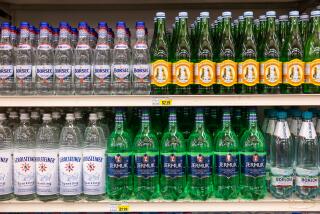A Pair of Sparkling Debuts
“Hey, Champagne! So what’s the occasion?”
That, in a nutshell, is why sparkling wine sales are flat as, well, last week’s Champagne. People simply don’t drink bubbly in this country unless it’s a special occasion--a wedding, a graduation, New Year’s Eve. Sales are up in June and December, sluggish at other times. On top of that, for the last five years sparkling wines have been selling poorly even in season.
So here, where angels fear to tread, come . . . two brand new sparkling wines.
The first is J, which aims to be the American Dom Perignon. It comes from Jordan, the winery that more than a decade ago unveiled a 1976 Cabernet Sauvignon that was a trendmaker among California Cabernets--drinkable upon release.
The Jordan winery is designed with dining in mind. Throughout the years, Tom and Sally Jordan have begun meals at the secluded Sonoma County property by serving their visitors premium sparkling wines--made by other wineries. One of the Jordans’ favorites was from Iron Horse, using grapes grown in the nearby Russian River area.
Jordan, a successful oil industry entrepreneur, began his own sparkling wine project in 1987. He first sent wine maker Rob Davis and consultant Andre Tchelistcheff to the Champagne district of France to do research, then hired Claude Thibaut, who had made those Iron Horse wines Jordan liked.
The result is 1987 J, a well-balanced, marvelously delicate yet flavorful sparkling wine. Made of 54% Chardonnay and the remainder Pinot Noir, the wine is mostly from Russian River fruit, making it not unlike the superb Iron Horse wines. To be released April 1, J--in a unique bottle and sporting a silk-screened letter J on the bottle--will sell for $21.50.
This wine is clearly designed to be a special-occasion product, to be marketed to that very niche that has recently had poor sales. But industry analysts believe that the quality and packaging of this wine are so good that there should be no problem selling all 12,000 cases.
There will only be 5,000 cases of the new Robert Mondavi sparkling wine when it debuts in October. The result of two decades of experimentation, it too is targeted at that special-occasion niche.
Both of these products were conceived long before the slump, which is much worse than that affecting other premium wines, began.
Sparkling wine consumption reached its peak in the United States in 1985, when we drank 19.2 million cases of it. By 1990, that figure had dropped 24% to 14.6 million cases. Sales of sparkling wine in December 1990 were 23% below those of December 1989.
But there is still hope for American sparkling wine. Jon Fredrikson, a San Francisco analyst, says that sales of French sparkling wine are down, leaving, “a lot of room for growth in the high-end California sparkling wines.”
“Until recently you could still find Mumm Extra Dry at $11.99. Well, now it’s up to near $20, with more increases coming. The prices are drifting up, and this opens the door for these kinds of products like the Jordan and the Mondavi and others,” he said.
One industry analyst pointed out sparkling wine has a unique problem: “People are under the misunderstanding that you get drunk faster on Champagne than you do on table wine. It’s not the product, it’s the way it’s consumed.”
Sparkling wine is typically consumed as an aperitif, which means two things: It’s consumed on an empty stomach and it’s consumed when people are thirsty. And, because people don’t want the bubbles to go away, they drink it faster.
Actually, when sparkling wine is consumed during a meal, the actual alcohol intake is lower than with some other table wines. The alcohol in sparkling wine is usually about 12%, compared with 13% and more in Chardonnay and Cabernet.
Wine of the Week
1988 Bruno Giacosa Nebbiolo D’Alba ($17)-- Wines from the great 1988 vintage in Italy are appearing on store shelves--and they are excellent. This deeply rich, complex and most appealing Barolo-styled wine is made from the grape that makes Italy’s No. 1 prized red. The tar, rose petal and cherry aroma is overlaid with a hint of cedar. The wine is fairly tart, but it works well with hearty foods and should age well for a number of years.
More to Read
Eat your way across L.A.
Get our weekly Tasting Notes newsletter for reviews, news and more.
You may occasionally receive promotional content from the Los Angeles Times.









